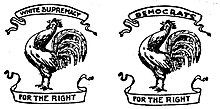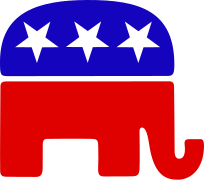Draft:Political party mascot
A party mascot might be an electoral symbol. They often act as personifications of their respective parties.
United States
[edit]Democratic Party
[edit]Donkey
[edit]The most common mascot symbol for the party has been the donkey, or jackass.[1] Andrew Jackson's enemies twisted his name to "jackass" as a term of ridicule regarding a stupid and stubborn animal. However, the Democrats liked the common-man implications and picked it up too, therefore the image persisted and evolved.[2] Its most lasting impression came from the cartoons of Thomas Nast from 1870 in Harper's Weekly. Cartoonists followed Nast and used the donkey to represent the Democrats and the elephant to represent the Republicans.
-
"A Live Jackass Kicking a Dead Lion" by Thomas Nast, Harper's Weekly, January 19, 1870
-
The donkey party logo remains a well-known symbol for the Democratic Party despite not being the official logo of the party.
Other
[edit]
In the early 20th century, the traditional symbol of the Democratic Party in Indiana, Kentucky, Oklahoma and Ohio was the rooster, as opposed to the Republican eagle.[5] The rooster was also adopted as an official symbol of the national Democratic Party.[6] In 1904, the Alabama Democratic Party chose, as the logo to put on its ballots, a rooster with the motto "White supremacy – For the right."[7] The words "White supremacy" were replaced with "Democrats" in 1966.[8][3] In 1996, the Alabama Democratic Party dropped the rooster, citing racist and white supremacist connotations linked with the symbol.[4] The rooster symbol still appears on Oklahoma, Kentucky, Indiana, and West Virginia ballots.[5] In New York, the Democratic ballot symbol is a five-pointed star.[9]
Republican Party
[edit]Elephant
[edit]The traditional mascot of the party is the elephant. A political cartoon by Thomas Nast, published in Harper's Weekly on November 7, 1874, is considered the first important use of the symbol.[10]
-
An 1874 cartoon by Thomas Nast, featuring the first notable appearance of the Republican elephant[11]
-
The red, white and blue elephant
-
A GOP banner logo, c. 2017
Others
[edit]An alternate symbol of the Republican Party in states such as Indiana, New York and Ohio is the bald eagle as opposed to the Democratic rooster or the Democratic five-pointed star.[12][13] In Kentucky, the log cabin is a symbol of the Republican Party.[14]
Third Parties
[edit]In the 1990s, several state Libertarian parties adopted the Liberty Penguin ("LP") as their official mascot.[15] Another mascot is the Libertarian porcupine, an icon that was originally designed by Kevin Breen in March 2006 and inspired by the logo of the Free State Project (FSP).[16]
Alaskan Independence Party
-
Libertarian Party
Usage in other countries
[edit]The elephant mascot was adopted by the True Whig Party which like the GOP traces their history back to the Whig Party.[17][18]
In the 1999 European Parliament election in Italy, two lists tried to imitate the American parties. The right-wing National Alliance – Segni Pact adopted the republican elephant.[19] The alliance, known informally as "the Elephant", won 10.30% of the vote and 9 seats.[20]
-
National Alliance – Segni Pact symbol
List of party mascots
[edit]References
[edit]- ^ see "History of the Democratic Donkey"
- ^ John William Ward (1962). Andrew Jackson: Symbol for an Age. Oxford Up. pp. 87–88. ISBN 9780199923205.
- ^ a b Ingram, Bob (January 21, 1966). "Loyalist Faction Wins; 'White Supremacy' Goes". Birmingham News. Retrieved July 22, 2017.
- ^ a b "Bad symbol removed". Times Daily. March 14, 1996. p. 7B. Archived from the original on May 31, 2022. Retrieved July 22, 2017.
- ^ a b "Barbour County, West Virginia General Election Ballot" (PDF). November 4, 2008. Archived from the original (PDF) on October 24, 2008.
- ^ Seidman, Steven (June 12, 2010). "The Rooster as the Symbol of the U.S. Democratic Party". Ithaca College. Archived from the original on October 24, 2017.
- ^ "FACT CHECK: Did a State Democratic Party Logo Once Feature the Slogan 'White Supremacy'?". Snopes.com. September 25, 2017. Retrieved December 9, 2017.
- ^ "Alabama Democratic Party Strikes 'White Supremacy' From Its Motto". Ocala Star-Banner. Associated Press. January 23, 1966. p. 1. Archived from the original on November 28, 2020. Retrieved July 22, 2017.
- ^ Lopez, Tomas (October 23, 2014). "Poor Ballot Design Hurts New York's Minor Parties ... Again". Brennan Center for Justice. Archived from the original on February 7, 2017. Retrieved February 6, 2017.
- ^ "Cartoon of the Day". HarpWeek.com. Archived from the original on September 21, 2011. Retrieved December 27, 2016.
- ^ "The Third-Term Panic". Cartoon of the Day. November 7, 2003. Archived from the original on September 21, 2011. Retrieved September 5, 2011.
- ^ "Ballots of United States: Indiana". University of North Carolina. Archived from the original on May 25, 2017. Retrieved February 6, 2017.
- ^ Lopez, Tomas (October 23, 2014). "Poor Ballot Design Hurts New York's Minor Parties ... Again". Brennan Center for Justice. Archived from the original on February 7, 2017. Retrieved February 6, 2017.
- ^ "See Sample Ballots for Today's Primary Elections". West Kentucky Star. May 19, 2015. Archived from the original on February 7, 2017. Retrieved February 6, 2017.
- ^ Drake, Kerry (July 26, 1996). "Laramie Libertarians adopt 'Liberty Penguin'". Casper Star Tribune; "Libertarian picks penguin representation". Fort Myers News Press. November 11, 1997; "Pragmatic penguin just the ticket for Wyo. Libertarians". Denver Post. Associated Press. September 6, 1996; "Libertarians Adopt County Artist's Design". Grainger County News. Grainger County, TN. April 22, 1999.
- ^ "Libertarian Porcupine" Archived October 25, 2012, at the Wayback Machine. Retrieved September 27, 2012.
- ^ Foreign Areas Studies Division (1964). Area Handbook for Liberia. p. 203.
- ^ "The True Whig Ascendancy". GlobalSecurity.org.
- ^ Giuseppe Guarino (5 July 2013). "Quando Fini e Mariotto lanciarono l'elefantino | Legno sopra un'onda". peppeguarino.wordpress.com. Retrieved 2014-07-10.
- ^ Mark Gilbert; Gianfranco Pasquino (January 2000). Italian Politics: The Faltering Transition. Berghahn Books. p. 93. ISBN 978-1-57181-840-9.
- ^ a b https://familiabateyera.com/se-origina-pelea-de-hombres-en-la-gallera-de-duverge/
- ^ "En 1902 aparecen los "Bolos" y los "Coludos" como grupos políticos - NOTIALTERNATIVO.·". Archived from the original on 2023-06-10.
- ^ https://books.google.com/books?id=tFToAgAAQBAJ&dq=%22Bolos%22+%22Coludos%22&pg=PA15 :15
- ^ Michael Surber (19 August 2019). "Ein SVP-Plakat der Kategorie «bireweich»". Neue Zürcher Zeitung (in German). Retrieved 2 August 2024.
- ^ "Wie ein Tweet von Bodo Ramelow unser Maskottchen ins Leben rief". Alliance for Thuringia (in German). 13 October 2023. Retrieved 2 August 2024.



![An 1874 cartoon by Thomas Nast, featuring the first notable appearance of the Republican elephant[11]](http://upload.wikimedia.org/wikipedia/commons/thumb/2/27/NastRepublicanElephant.jpg/270px-NastRepublicanElephant.jpg)












